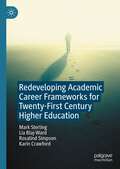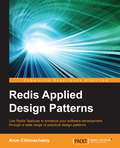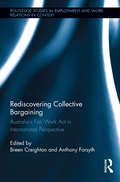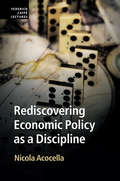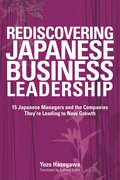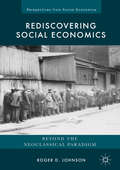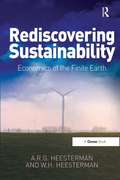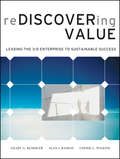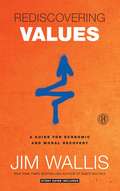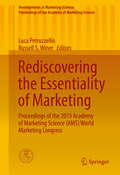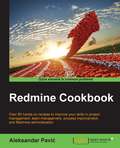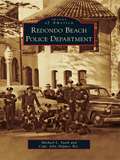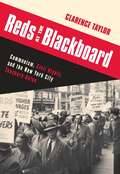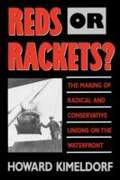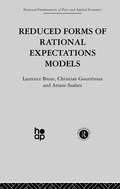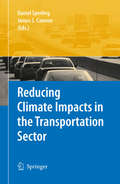- Table View
- List View
Redeveloping Academic Career Frameworks for Twenty-First Century Higher Education
by Karin Crawford Lia Blaj-Ward Rosalind Simpson Mark SterlingThis book spotlights new pathways for academic career progression beyond the traditional teaching-and-research model. It sets out key parameters for constructive conversations about alignment to these new pathways, which are examined from the point of view of individuals at different stages in their careers, as well as at an institutional level. The authors offer guidance on how to implement new pathways and how to realign professional development for academics so that the new pathways fully achieve their purpose to support universities’ contribution to society. The volume will appeal to academics in higher education, as well as those involved in the redesign and implementation of academic career frameworks from a variety of positions in a university.
Redfin
by Julia Kelley Marco Di MaggioRedfin, a technology-powered residential real estate brokerage, was founded in 2002 with the intention of using technology to disrupt the real estate industry. Over the next 15 years, Redfin made several changes to its business model. Initially, the company provided less support than a traditional real estate brokerage but helped home buyers and sellers save more money. Over time, in response to customer feedback, Redfin increased the level of customer service it provided while decreasing the amount customers saved, instead relying on its unique online tools to differentiate itself from other real estate brokerages. In July 2017, Redfin went public at a $1.73 billion valuation. Now, in late 2017, CEO Glenn Kelman had to decide what Redfin’s top strategic priority should be. Redfin could try to increase its market share, which was currently less than 2% even in the company’s top markets, or it could focus on balancing costs and improving its bottom line.
Redfin: Redefine Real Estate
by Hong Luo Huafeng YuFounded in 2004, Redfin envisioned a light-touch model in which clients self-served using the digital platform in exchange for a significantly lower fee than traditional agents. Realizing the narrow appeal of its initial model, Redfin had made significant changes to its strategy while maintaining some key distinctive choices. As of 2016, Redfin served in more than 80 markets throughout the U.S., employed over 700 full-time agents, and had grown over 40% annually since 2014. With additional capital raised through an IPO, Glenn Kelman faced decisions on how to allocate these resources in order to grow. Should Redfin adjust its advertising strategy? Should it reconsider the policy of hiring lead agents only as full-time employees? Should Redfin purchase homes and hold inventories?
Redifferentiating Products and Services: Employ an Entrepreneurial Mindset
by Rita Gunther Mcgrath Ian MacmillanThe current business environment is tumultuous and full of uncertainty. What you need is an entrepreneurial mindset--a way of thinking about your business that captures the benefits of uncertainty. The key aspect of establishing an entrepreneurial mindset is encouraging everyone to find opportunities to change your business model. This chapter focuses on redifferentiating products and services using consumption chain analysis and quizzing. This chapter is excerpted from "The Entrepreneurial Mindset: Strategies for Continuously Creating Opportunity in an Age of Uncertainty."
Redis Applied Design Patterns
by Arun ChinnachamyWith new data stores making their way onto the market, it's necessary for businesses to understand the features and techniques to use data stores most effectively. Redis Applied Design Patterns is designed to guide you into the world of Redis and will help you understand how business problems can be solved using Redis in your application stack. This book introduces you to the NoSQL way of thinking and how it is different from SQL. It helps you understand various functionality of Redis through a series of use cases designed for you to learn the more complex and less well-known features of Redis in an incremental way. By the time you've read this book, you will be capable of designing a system using Redis. This book will guide you through various use cases along with code samples, easy-to-understand diagrams, and tips to help you take advantage of Redis. The book explains the benefits of adding Redis to the application stack and discusses various practical use cases for Redis such as the caching system, commenting system, and social networking.
Rediscovering Apprenticeship
by Felix Rauner Erica SmithThe rediscovery of the value of apprenticeships has been one of the most significant trends in vocational education in recent years, and has prompted an array of research and development projects in countries around the world. In this volume, the renewed interest in the apprenticeship tradition and the various steps towards the implementation of innovative apprenticeship programmes are analysed and discussed from different perspectives. Beginning with a number of chapters that describe recent developments in apprenticeship training in different national contexts, the book moves on to analyze the way in which both the quality and profitability of apprenticeship act in concert as the most influential drivers of innovation in this field. In sum, this book makes an important contribution to the international literature on apprenticeship. It draws together some of the leading researchers in the area, and with its overview of a number of national Vocational Education and Training (VET) projects, provides a body of knowledge on current practices and issues that has previously been lacking in this complex interdisciplinary field. The lessons learned from countries' experiences, as presented in this book, provide a valuable platform for policy-makers and scholars alike.
Rediscovering Collective Bargaining: Australia's Fair Work Act in International Perspective (Routledge Studies in Employment and Work Relations in Context)
by Breen Creighton Anthony ForsythThis book examines countries that have tried, with varying degrees of success, to use legislative strategies to encourage and support collective bargaining, including Australia’s Fair Work Act. It is the first major study of the operation and impact of the new collective bargaining framework introduced under the Fair Work Act, combining theoretical and practical perspectives. In addition, a number of comparative pieces provide rich insights into the Australian legislation’s adaptation of concepts from overseas collective bargaining systems – including good faith bargaining, and majority employee support as the basis for establishing bargaining rights. Contributors to this volume are all leading labor law, industrial relations, and human resource management scholars from Australia, and from Britain, Canada, New Zealand and the United States.
Rediscovering Economic Policy as a Discipline (Federico Caffè Lectures)
by Nicola AcocellaGovernment interventions in market failures can encounter objections from those who doubt their efficacy. Acocella, a leading expert on economic policy, counters these unfounded criticisms, making the convincing case for the foundation, coordination and reach of government action through economic policy. Arguing for the governmental potential to devise democratic, fair and effective institutions and policies, this book also demonstrates the validity of the principles outlined by Frisch and Tinbergen, amongst others, for controlling the economy, in a strategic context, equivalent to the rational expectations assumption. Demonstrating how unconventional monetary policies (such as macro-prudential regulation, new fiscal rules, and new forms of international policy coordination) can offer an effective response to the multiplicity of current economic issues, the recent financial crisis arguably indicates that economic policy must once again take centre stage as the applied complement to mainstream economic theory.
Rediscovering Japanese Business Leadership
by Yozo Hasegawa Tony KimmWho are Asia's biggest business leaders? What kind of leadership skills and philosophies do they possess that have put them at the forefront of their respective industries? What makes these business leaders, in particular, best-equipped to meet the challenges of a 21st century global economy? In Rediscovering Japanese Business Leadership, we gain insights into the leadership strategies of Japan's most successful global brands, including Toyota, Canon, and Nintendo. This book will be the first title in a series on Asian business leaders, leading companies and corporate philosophies in the 21st century. The inaugural volume will focus on business leaders and strategies at Japanese companies that are not only driving and reshaping their respective industries in the 21st century, but are demonstrating a knack for consistently meeting the various challenges of today's rapidly changing world.
Rediscovering Social Economics
by Roger D. JohnsonThis book argues that economists need to reengage with societal issues, such as justice and fairness in distribution, that inevitably arise when discussing the basic economic problem of unlimited human wants and finite resources. Approaching the problem through a history of economic thought, Johnson reexamines Adam Smith's contributions to show how they reach beyond neoclassical models that are too simplistic to reflect the growing interdependencies of market economies. He breaks down supposedly value-free neoclassical postulates to expose normative assumptions about economics and justice, demonstrating, for example, that the concept of market equilibrium is problematic because need-based behavior can produce involuntary unemployment even when a competitive labor market achieves equilibrium.
Rediscovering Sustainability: Economics of the Finite Earth
by A.R.G. HeestermanDrawing on historical and current data, this thought-provoking book summarises the pathways to the present predicament and maps out strategies to develop financial and economic systems for a sustainable world. The content is arranged in three parts addressing 'Stylised Market Equilibrium', 'The Real Market Economy', and 'Present Affluence Versus the Future'. In Rediscovering Sustainability the authors help bridge the gap in understanding between scientists and the green movement on the one side and many economists on the other. Greens worry about catastrophic climate change and anthropocene mass extinction. Economists express reservations about spending substantial amounts of money on preventing environmental degradation. Aart and Wiebina Heesterman argue that there are inherent limitations in standard economics which cause blind spots in its environmental economics sub-field, as well as issues to do with simple lack of knowledge. In this timely book, the limitations of the neoclassical economics framework are examined. The authors explore the relationship between Keynesian aggregate economics and financial sustainability, as well as that between scale economies, locational economics and the understated cost of fuel for transport. The impact of economic theory on practice is examined. Conventional economic theory and political compromise bear unhelpfully on an energy market constrained by emissions targets. Rediscovering Sustainability is an invaluable aid to understanding for those teaching, studying, campaigning, policy-making, or involved with the science or politics of environmental and sustainability issues. It is also a book for those concerned with the application of economic theory in any context.
Rediscovering Value
by Geary A. Rummler Cherie L. Wilkins Alan J. Ramias"To paraphrase a number of philosophers, the major challenge any executive or manager (and especially any CEO) faces is that his or her experience of the reality of the organization is not the same as the reality itself. How then does an executive: 1) develop a more accurate and complete representation of the organization, 2) identify critical business issues and improvement opportunities across this system, 3) design a way forward, and 4) install the feedback and measurement mechanisms necessary to ensure the organizational system delivers the performance and stays on course? This is where this book comes into its own."-- Michael DeNoma president and CEO, Chinatrust Commercial Bank"Every CEO (or executive managing a business) should read and understand Rediscovering Value if they want to effectively lead and manage their company. Leading a company without an understanding of the value and resource dimensions and how to manage them is like flying an airplane without a navigation system. The team at PDL has done an unbelievable job of describing the principles of an organization and how to effectively organize, lead, and manage the enterprise. Our company used PDL's systems approach to planning and managing and it was like turning on the lights in a dark room. Our people became process- and work-focused and morale improved dramatically as we moved away from the silo approach of running a business. Rediscovering Value is a must-read for any executive."-- Steve Hassenfelt CEO, Granville Capital, Inc.From author of the acclaimed Improving Performance, an exploration of the concept of Value Management and technology, comes the next step resource that introduces the transformation model. Rediscovering Value gives a preliminary description of the SOE phase, and covers the dimensions of the model. The book dissects each phase of the model, and describes what is accomplished along each dimension, the criteria to reach the next phase, and the key challenges of each phase (Stabilize, Optimize, Exploit in detail). It lays out the success factors for effective process design, improvement, and management.
Rediscovering Values
by Jim WallisWhen we start with the wrong question, no matter how good an answer we get, it won't give us the results we want. Rather than joining the throngs who are asking, When will this economic crisis be over? Jim Wallis says the right question to ask is How will this crisis change us? The worst thing we can do now, Wallis tells us, is to go back to normal. Normal is what got us into this situation. We need a new normal, and this economic crisis is an invitation to discover what that means. Some of the principles Wallis unpacks for our new normal are . . .* Spending money we don't have for things we don't need is a bad foundation for an economy or a family.* It's time to stop keeping up with the Joneses and start making sure the Joneses are okay.* The values of commercials and billboards are not the things we want to teach our children.* Care for the poor is not just a moral duty but is critical for the common good.* A healthy society is a balanced society in which markets, the government, and our communities all play a role.* The operating principle of God's economy says that there is enough if we share it.* And much, much more . . .In the pages of this book, Wallis provides us with a moral compass for this new economy--one that will guide us on Wall Street, Main Street, and Your Street.Embracing a New Economy Getting back to "the way things were" is not an option. It is time we take our economic uncertainty and use it to find some moral clarity. Too often we have been ruled by the maxims that greed is good, it's all about me, and I want it now. Those can be challenged only with some of our oldest and best values--enough is enough, we are in it together, and thinking not just for tomorrow but for future generations. Jim Wallis shows that the solution to our problems will be found only as individuals, families, friends, churches, mosques, synagogues, and entire communities wrestle with the question of values together.
Rediscovering Values
by Jim WallisWhen we start with the wrong question, no matter how good an answer we get, it won't give us the results we want. Rather than joining the throngs who are asking, When will this economic crisis be over? Jim Wallis says the right question to ask is How will this crisis change us? The worst thing we can do now, Wallis tells us, is to go back to normal. Normal is what got us into this situation. We need a new normal, and this economic crisis is an invitation to discover what that means. Some of the principles Wallis unpacks for our new normal are . . .* Spending money we don't have for things we don't need is a bad foundation for an economy or a family.* It's time to stop keeping up with the Joneses and start making sure the Joneses are okay.* The values of commercials and billboards are not the things we want to teach our children.* Care for the poor is not just a moral duty but is critical for the common good.* A healthy society is a balanced society in which markets, the government, and our communities all play a role.* The operating principle of God's economy says that there is enough if we share it.* And much, much more . . .In the pages of this book, Wallis provides us with a moral compass for this new economy--one that will guide us on Wall Street, Main Street, and Your Street.Embracing a New Economy Getting back to "the way things were" is not an option. It is time we take our economic uncertainty and use it to find some moral clarity. Too often we have been ruled by the maxims that greed is good, it's all about me, and I want it now. Those can be challenged only with some of our oldest and best values--enough is enough, we are in it together, and thinking not just for tomorrow but for future generations. Jim Wallis shows that the solution to our problems will be found only as individuals, families, friends, churches, mosques, synagogues, and entire communities wrestle with the question of values together.
Rediscovering the Essentiality of Marketing
by Luca Petruzzellis Russell S. WinerThis book contains the full proceedings of the 2015 Academy of Marketing Science World Marketing Congress held in Bari, Italy. The current worldwide business environment is leading marketing scholars and practitioners to reconsider a number of historical and current views of the marketplace and how it functions. Further, determining new marketing theories and practical methods whose effectiveness can be truly measured must be added to the list of current challenges for today and tomorrow. In such a period in marketing history, achieving and managing efficient and effective marketing actions is a necessity. Determining such actions is based on practical experience, solid theory and appropriate research methodology. The enclosed papers focus on new research ideas on vibrant topics that can help academics and practitioners gain new perspectives and insights into today's turbulent marketplace. Founded in 1971, the Academy of Marketing Science is an international organization dedicated to promoting timely explorations of phenomena related to the science of marketing in theory, research, and practice. Among its services to members and the community at large, the Academy offers conferences, congresses and symposia that attract delegates from around the world. Presentations from these events are published in this Proceedings series, which offers a comprehensive archive of volumes reflecting the evolution of the field. Volumes deliver cutting-edge research and insights, complimenting the Academy's flagship journals, Journal of the Academy of Marketing Science (JAMS) and AMS Review. Volumes are edited by leading scholars and practitioners across a wide range of subject areas in marketing science.
Redmine Cookbook
by Aleksandar PavicOver 80 hands-on recipes to improve your skills in project management, team management, process improvement, and Redmine administration About This Book * Efficiently install and customize Redmine for your own infrastructure, whether that be Microsoft or open source * Manage multiple projects with multiple teams across the globe in a standardized and effective way * Customize Redmine to fit your organisation's specific and unique needs Who This Book Is For This book is for those who working in management or administrator positions who are already using Redmine or are willing to start using it for project management, tracking, collaboration, or process management. Additionally, individual developers or teams can benefit from recipes related to code repositories, bug tracking, and software project management. What You Will Learn * Make Redmine run on Microsoft SQL Server with IIS * Enjoy the benefits of updating the code on a real-time basis and maintaining consistency * Manage multiple projects and teams simultaneously * Leverage Redmine features to enhance team's performance * Use Redmine for SCRUM and Agile methodologies * Deploy Redmine for Service Desk * Customize the user experience by manually tracking the ongoing projects * Extend Redmine through various plugins In Detail In a variety of online project management tools, Redmine markets itself as offering flexibility. Choosing the right management tool can mean the difference between the success and failure of a project. Flexible project management tools bend themselves to fit your needs, whether that's communication regarding a simple project, or collaboration, or more complex project methodology such as SCRUM, or an issue-code relationship, or the need of different methodology for your project. Whether you are project manager or system administrator, this book provides valuable recipes to get the best possible performance out of your team, organization, infrastructure, and Redmine itself. Through a series of carefully crafted recipes covering the nitty-gritty of Redmine, you'll be guided through the installation of Redmine, as well as how to fine-tune and customize your Redmine installation. Finally, we walk you through integrating Redmine with other softwares and databases like Tortoise SVN and Visual Studio and troubleshooting Redmine. Style and approach This book follows a step-by-step recipe-based approach. Detailed prerequisites make each recipe easy to follow and apply in practice in any kind of live environment.
Redondo Beach Police Department (Images of America)
by Ret. Capt. Skipper Michael L. StarkThe Redondo Beach Police Department dates to May 9, 1892, when Marshall S. Rogers was appointed as the city's first marshal. One of the first city ordinances prohibited the discharge of firearms within city limits and provided the option for hiring of a deputy "if needed." He was needed, of course, as the city would grow into a major West Coast resort by the 1920s. The department adapted through the changes brought on by the Depression, World War II, and the postwar boom, serving and protecting citizens and fighting crime both unique to beach-city life as well as changing times while enforcing all laws for residents and tourists alike across the dawns of two centuries. In the 21st century, more than 250 sworn officers, support personnel, and volunteers serve one of Southern California's most respected and innovative departments.
Redpath
by Richard FeltoeRedpath, today a household name for sugar in Canada, has its roots in the story of an enterprising Scots immigrant, initially a stone mason and later a building contractor during the boom days of Montreal’s growth from a small provincial centre to a major North American city. <P><P>In 1854, the ever-energetic John Redpath, by then a self-made millionaire in his late fifties, launched a new career as an industrialist. With his son, Peter, and the gifted George Alexander Drummond as manager, he established Canada’s first successful sugar refinery. <P><P>The Redpath story encompasses the influence of sugar as an economic force, the emergence of the elegant social life of cosmopolitan Montreal and a hind-sight view of the complexities of the love-hate relationship between government and business. <P><P>This, the first of two volumes, moves through Canada’s period of extensive industrialization to the turn of the century, the impact of World War I and concludes in the post-war years. Throughout this period, the familiar Redpath trademark, a reproduction of John Redpath’s signature, is a reminder of the heritage inherent in Canada’s business and social history.
Redressing Historical Injustice: Self-Ownership, Property Rights and Economic Equality (Palgrave Studies in Classical Liberalism)
by David Gordon Wanjiru NjoyaThis book offers an alternative to perspectives of distributive justice which fail to resolve economic inequality and exacerbate social problems by ignoring the real causes of inequality. The main impact of the book is to highlight the importance of self-ownership and private property, showing how market participation advances liberty and prosperity. The idea that we should pay reparations to disadvantaged racial groups as compensation for historical injustice is deeply contested. The debates often focus on the practical implications of paying reparations, but overlook more fundamental questions about the meaning of justice. What is justice? What are the implications of wealth redistribution for individual liberty and the rule of law? This book answers these questions through an analysis of classical liberal perspectives in law, philosophy and economics. The book questions whether economic inequality stems from historical injustice, and explores the wider implications of attempting to create equal outcomes through legislative mandates. The book argues that free markets, resting on libertarian rights, are the best way to help disadvantaged members of society and to create the conditions more likely to advance economic equality. The book will be of interest to researchers and students of economics, law, politics and philosophy.
Reds at the Blackboard: Communism, Civil Rights, and the New York City Teachers Union
by Clarence TaylorThe New York City Teachers Union shares a deep history with the American left, having participated in some of its most explosive battles. Established in 1916, the union maintained an early, unofficial partnership with the American Communist Party, winning key union positions and advocating a number of Party goals. Clarence Taylor recounts this pivotal relationship and the backlash it created, as the union threw its support behind controversial policies and rights movements. Taylor's research reaffirms the party's close ties with the union-yet it also makes clear that the organization was anything but a puppet of Communist power.Reds at the Blackboard showcases the rise of a unique type of unionism that would later dominate the organizational efforts behind civil rights, academic freedom, and the empowerment of blacks and Latinos. Through its affiliation with the Communist Party, the union pioneered what would later become social movement unionism, solidifying ties with labor groups, black and Latino parents, and civil rights organizations to acquire greater school and community resources. It also militantly fought to improve working conditions for teachers while championing broader social concerns. For the first time, Taylor reveals the union's early growth and the somewhat illegal attempts by the Board of Education to eradicate the group. He describes how the infamous Red Squad and other undercover agents worked with the board to bring down the union and how the union and its opponents wrestled with charges of anti-Semitism.
Reds or Rackets? The Making of Radical and Conservative Unions on the Waterfront
by Howard KimeldorfWhy is the American working class different? For generations, scholars and activists alike have wrestled with this question, with an eye to explaining why workers in the United States are not more like their radicalized European counterparts. Approaching the question from a different angle, Reds or Rackets? provides a fascinating examination of the American labor movement from the inside out, as it were, by analyzing the divergent sources of radicalism and conservatism within it. Kimeldorf focuses on the political contrast between East and West Coast longshoremen from World War I through the early years of the Cold War, when the difference between the two unions was greatest. He explores the politics of the West Coast union that developed into a hot bed of working class insurgency and contrasts it with the conservative and racket-ridden East Coast longshoreman's union. Two unions, based in the same industry-- as different as night and day. The question posed by Kimeldorf is, why? Why "reds" on one coast and racketeers on the other? To answer this question Kimeldorf provides a systematic comparison of the two unions, illuminating the political consequences of occupational recruitment, industry structure, mobilization strategies, and industrial conflict during this period. In doing so, Reds or Rackets? sheds new light on the structural and historical bases of radical and conservative unionism. More than a comparative study of two unions, Reds or Rackets? is an exploration of the dynamics of trade unionism, sources of membership loyalty, and neglected aspects of working class consciousness. It is an incisive and valuable study that will appeal to historians, social scientists, and anyone interested in understanding the political trajectory of twentieth-century American labor.
Reduce Inequality, Increase Economic Growth: A Conversation with Joseph Stiglitz
by Joseph Stiglitz Shari SpiegelJoseph Stiglitz, winner of the Nobel Prize for Economics, discusses the state of the world's economy in this interview, offering policy interventions to better serve society's economic needs. Pointing to a grave failure of modern macroeconomic theory to predict the financial crisis, Stiglitz calls for new economic models from within the field to build a framework that maximizes individual capacity and advances society's interests.
Reduced Forms of Rational Expectations Models (Fundamentals Of Pure And Applied Economics Ser.)
by L. Broze C. Gourieroux A. SzafarzA comprehensive exposition of rational expectations models is provided here, working up from simple univariate models to more sophisticated multivariate and non-linear models.
ReducedEffort® Changeover: The Lean Way to Quickly Reduce Changeover Downtime, Second Edition
by Ron HeiskellReducedEffort® Changeover: The Lean Way to Quickly Reduce Changeover Downtime provides a step-by-step guide for conducting a Kaizen event that empowers the people who do the work to improve how that work is done. Packed with tips, tools, and examples, this practical guide begins with a clear description of the Lean principles underlying the ReducedEffort Changeover system. In addition, it explains how and why reducing the effort always reduces the time of converting a machine, line, or process from one product to another. In this book, you’ll find everything you need to quickly and dramatically reduce the effort and time of any process using the ReducedEffort method. This is not another book about how to do SMED. Like SMED, ReducedEffort Changeover (REC) does reduce changeover time, but REC is not SMED. SMED, Single Minute (or digit) Exchange of Dies, developed by Dr. Shigeo Shingo, has been the process used for many years by countless manufacturing plants to reduce changeover time. The SMED process was used in Toyota to reduce the changeover of a 1,000-ton stamping press from four hours to three minutes. As a Lean-based process, the REC system focuses on reducing the labor, not the time, involved in changing over a machine to work on a different product. With REC, there are no Standard Operation Combination Sheets to fill out and no Problem Identification Sheets to complete, and it does not require the arduous chore of timing every task, as SMED does. Very little capital investment is required with REC. Unlike SMED, it does not require management-approved funding to achieve substantial results. Because REC is not capital-driven, management does not need to drive the process. The operators will drive the process because it reduces their labor. One of the biggest advantages of REC over SMED is that operators will readily accept the process, and more important, they will want to sustain it. The reason for this is quite simple and will become evident when the REC process is defined. REC takes SMED to a new level that is easier and faster both to implement and to deliver sustainable results.
Reducing Climate Impacts in the Transportation Sector
by James S. Cannon Daniel SperlingMore than 250 experts from around the world gathered at the Asilomar Transportation and Energy Conference in August 2007 to tackle what many agree is the greatest environmental challenge the world faces: climate change. This 11th Biennial Conference, organized under the auspices of the Energy and Alternative Fuels Committees of the U.S. Transportation Research Board, examined key climate change policy issues and strategies to combat climate impacts from the transportation sector, a leading source of greenhouse gas emissions. This book includes chapters by leading presenters at the Asilomar Conference that reflect the most current views of the world's experts about a critical and rapidly evolving energy and environmental problem. The chapters in this book examine increasing worldwide emissions of greenhouse gases, uncertain oil supply, evolving climate change science, public attitudes toward climate change, and the implications for the U.S. of growth in China, India and elsewhere. They propose methods to reduce growth in vehicle travel through alternative fuel, new technologies, and land use planning. They examine the costs and the potential for greenhouse gas reduction through deployment of advanced technology and alternative fuels and propose strategies to motivate consumers to buy fuel efficient and alternative fuel vehicles, including heavy duty trucks.
